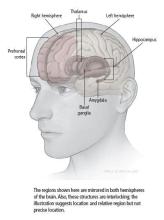Depression Is Linked to Hyperconnectivity of Brain Regions, a New Study Shows
Feb 21, 2012 11:17 AM EST
A new study reveals that people suffering from depression are characterized by an extreme synchronicity of brain regions that could indicate stymied, inflexible brains. Plus, Sharon Begley and Richard J. Davidson on the new science of feelings.
A study published today provides surprising new insight into what happens in depressed brains.
In people with depression, brain regions appear to be overly connected to one another, says the study, which is being published by UCLA’s Semel Institute for Neuroscience and Human Behavior. In turn, this excessive connectivity reduces the flexibility the brain needs to function properly.
“Depression is a whole brain disease,” says Dr. Andrew Leuchter, the Semel Institute neuroscientist who led the team that produced the study. “It’s not something that affects just one brain region, but that the entire organ doesn’t appear to be functioning very well.”
Joy Hirsch, a neuroscientist at Columbia who was not involved in this research, remarked on the usefulness of its finding. "Measures of connectivity between remote brain regions is an emerging metric to assess the strength of interactions between remote regions within the brain," she told The Daily Beast. "The discovery that these patterns are affected in depression is important because it says that information may be distributed differently. This is a novel insight."
For the research, Leuchter and his team used EEG to study the electrical activity happening in subjects’ brains while they were in a “resting state,” rather than responding to any particular test or stimulus.
EEG is the technique that involves sticking electrodes all over patients’ scalps—a technique that conjures the most old-fashioned picture of scientific research. Indeed, it is the oldest method we have for looking at the human brain’s moment-to-moment activity. It was invented in the 1940s.
But still it confers some advantages over the newer, flashier techniques that have come to dominate over the last two decades.
One particularly dominant technique is fMRI—otherwise known as the big metal magnet that requires you to lie down inside of it while it takes pictures of the motion of the blood inside your brain. Many fMRI studies have been done on depression that focus on only one individual brain region—the amygdala, for example, or the anterior cingulate. Whatever it is, this one region being studied in a given experiment is dubbed the “region of interest” and is investigated in a kind of a vacuum, in the hope that any aberration it shows could be the answer, or at least a big part of the answer, of what lies at the core of major depressive disorder. Depression researchers often become intensely specialized in the ins and outs of one brain structure, or one brain chemical.
By putting electrodes all over the subjects’ brains and using a new analytic method called “weighted brain analysis,” the UCLA team was able to ask, as Leuchter put it, “What’s going on in the brain as an entire organ?“
In almost every one of the 121 depressed patients studied by Leuchter’s team, there was a significantly increased “synchronicity” of rhythmic oscillations. That is, the same frequencies of rhythmic oscillations were emanating from different areas in the brain simultaneously, indicating that these brain structures were linked and working together like meshed gears.
“Depression is a whole brain disease. It’s not something that affects just one brain region.”
Leuchter’s team found that these patterns of hyperconnectivity were startlingly prevalent among their depressed patients, compared with the nondepressed patients they used as a control group.
“That was the eye opener for us—how widely brain regions are connected to one another” in the depressed patients, he said. “We saw that these areas were hyperconnected—that most brain areas were hyperconnected to other areas.”
It may not seem immediately clear why a hyperconnected brain would be a problem. After all, connectivity implies that one brain region is in robust communication with others all over the brain, linked up, evidently the very picture of a happy neural landscape.
“You would think that being able to synchronize different brain regions would be a good thing, but it’s only good if you’re later able to turn them off,” Leuchter says.
Rigidly synchronized brain regions produces a stymied, inflexible brain, a brain that can’t effectively move on to perform all of its minutely varied and specific tasks.
If the brain “is not able to desynchronize, if it is not able to turn off the connections to certain areas, then it is going to be inherently dysfunctional and ineffective,” Leuchter says. “If everything is online at once, it’s problematic for the brain to be able to specialize in any one area at once.”
Leuchter is hardly the only scientist emphasizing the holistic deficits of depression, which comes with a whole collection of symptoms: anxiety; loss of appetite, concentration, and memory; sleep disturbances; and, obviously, problems with mood regulation. Conceivably, Leuchter’s research might help to explain that long list of markedly distinct symptoms characterizing this disorder.
He acknowledges a couple of limitations to the study. His results don’t allow him to conclude whether this hyperconnectivity is something that changes with successful treatment or whether it always tends to mark the brains of people predisposed to depression.
Leuchter and his team also have not yet closely explored the link between an individual subject’s particular symptoms and that same subject’s pattern of hyperconnectivity. Once that is done, they may be able to draw conclusions about what specific connections might correlate with specific symptoms.
These are both areas of inquiry, he says, that can be usefully explored in future research.
People with depression appear to have hyperactive brain activity, says a study published online Tuesday that offers new insights into the brain dysfunction that causes depression.
Researchers at the University of California-Los Angeles studied the functional connections of the brain in 121 individuals, ages 21-80, who had been diagnosed with depression. They used quantitative electroencephalography to measure the synchronization of brain waves (electrical signals from the brain) to study networks among the different brain regions.
"All the depressed patients showed increased connectivity," says psychiatry professor Andrew Leuchter of UCLA's Semel Institute for Neuroscience and Human Behavior and lead author of the study, published in the international online journal PLoS ONE. "We know from brain science studying normal individuals that the connections are turning off and on all the time. If you take a snapshot of a depressed person's brain, you're going to find the connections turned on at any given time."
Similar research with fewer individuals, and using a different measurement tool, was published in 2010 in the scientific journal Proceedings of the National Academy of Sciences. Psychiatrist Yvette Sheline, director of the Center for Depression, Stress and Neuroimaging at Washington University School of Medicine in St. Louis, found that depressed subjects had increased connectivity to one specific brain region she studied.
"Any time you use a larger sample you have much more reliable data," says Sheline, whose work used fMRI to study brain connectivity in 24 people. The UCLA research studied a range of brain regions and, with 121 participants, is considered the largest of its kind.
Leuchter says that the brain needs to be able to process lots of different types of information and regulate many different processes.
"What our research shows is that the depressed brain appears to be less versatile. It's connecting all the regions all the time and is not able to shut down those connections in a normal way," says Leuchter, who also directs UCLA's Laboratory of Brain, Behavior and Pharmacology. "We don't know whether this hyperconnectivity is responsible for the symptoms."
Among symptoms associated with depression are anxiety, poor attention and concentration, memory issues and sleep disturbances.

